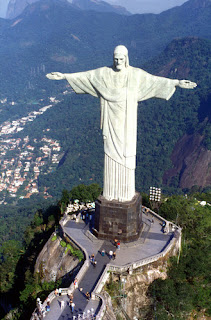New 7 wonders of the world... how wonderful are they?
 Finally! They've been announced. The so-called "new 7 wonders of the world" were unveiled in Lisbon, Portugal, today. And although a lot of people must be very excited about that, I am not.
Finally! They've been announced. The so-called "new 7 wonders of the world" were unveiled in Lisbon, Portugal, today. And although a lot of people must be very excited about that, I am not.As a bit of a background, the original wonders of the world were structures chosen by Greek wise men as the most impressive things to see in the world as they knew it. From all of them, only the Pyramid of Giza remains.
But about the "new" wonders (Colosseum in Italy, Chichen Itza in Mexico, Christ Redeemer in Rio de Janeiro, Macchu Picchu in Peru, Petra in Jordan, the Great Wall in China, and the Taj Mahal in India), can somebody tell me what makes them wonderful?
From the very starting point, a questions pops up in my mind: What was the criteria used to select the candidates? I believe that there was no criteria at all. Or, at least, not a logic one, because I remember that the only requisite to propose a "wonder" was that the structure or site should have been discovered or built before the year 2000.
If that's so, under what circumstances can you compare, for example, the Sydney Opera House and the Colosseum in Rome, to determine that one of them is "wonderful" and the other isn't? They don't belong to similar periods of time, and they represent totally different cultures. Simply no way to compare them. Both of them are impressive, and both of them are iconic. But should not be compared in order to get a winner and a loser.
Basically, that was the principle in which the contest of the "new 7 wonders of the world" was developed. And now, a posse of individuals named some structures and archaeological sites as wonders.
What I think is that people who cheer these designations of new wonders don't really understand the difference between "emblematic" and "wonderful". For example, one of the new (so-called) "wonders" is the Christ Redeemer in Rio de Janeiro, Brazil. Can you tell me what is wonderful in it? It is, indeed, an emblematic structure, as we couldn't think of Rio de Janeiro without the Christ Redeemer, but frankly speaking, there is no wonder on it. The same goes to other structures, such as the Taj Mahal, and virtually all of the landmarks (because that's all they are) that were once selected as candidates to become a "wonder".
If you ask me, this contest looked to me more like a popularity poll. Why shouldn't we consider, for example, the Nazca lines (Peru) as wonders? Or maybe the Kansai Airport (Japan), which was in fact built in the ocean? And what about the Itaipu Dam (Brazil)? Well, the reason should be very simple: They are less known, they are less popular, and they wouldn't make a good marketing campaign.
How excited are you about the designation of "new wonders" of the world? From my perspective, I see these new wonders of the world as a joke.




2 Comments:
I agree with the choice of Kansai Airport...but would like to add Charles Garnier's Paris Opera 1861-75; Le Corbusier's Chapel at Ronchamp, 1950-55; and Balthasar Neumann's Rezidenz at Wurzburg, 1744.
Indeed, Russel... I just came up with some examples from the top of my mind. But there are so many things to consider wonderful out there! Most of them unknown by a large portion of people. My question is: why aren't those things considered "wonderful" as well? Is it that, for example, Le Corbusier's Chapel, which didn't even reach the category of 'candidate', deserves less credit than the Eiffel Tower? Or the Taj Mahal, one of the "wonders", deserves much more admiration than the Chambord Castle in France, which wasn't considered to become a "wonder" at all? And the list of comparisons could go on forever... It's something just to think about...
Thanks for stopping by and posting your message, please come back soon!
Post a Comment
Subscribe to Post Comments [Atom]
<< Home